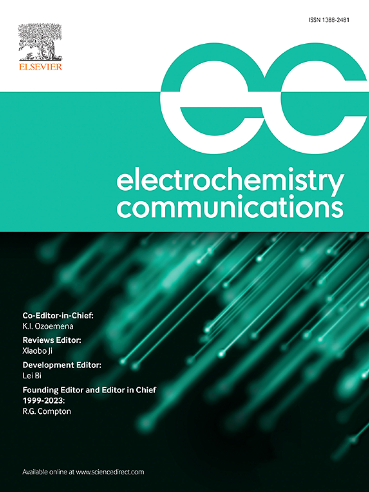Platinum-modified screen-printed carbon electrode integrated with molecularly imprinted polymer for highly selective electrochemical ethanol sensing
IF 4.2
3区 工程技术
Q2 ELECTROCHEMISTRY
引用次数: 0
Abstract
Ethanol is a type of alcohol often found in beverages, medicines, and fermented products, so an acceptable ethanol detection method is needed. An accurate ethanol detection method is the chromatography method, but its weaknesses are high operational costs and non-portability. Therefore, in this study, an electrochemical analysis technique was developed that can overcome this problem combined with the development of molecularly imprinted polymers (MIPs) for ethanol. MIPs were synthesized using ethanol as a template, methacrylic acid (MAA) as a monomer, divinylbenzene (DVB) as a crosslinker, and benzoyl peroxide (BPO) as an initiator by cooling and heating with cooling at −5 °C for 1 h, and heating at 80 °C for 7 h. The results of the MIPs synthesis were suspended in distilled water and dropped on a screen-printed carbon electrode (SPCE) for electrochemical sensor applications. Previously, SPCE was modified platinum (Pt) by electrodeposition with optimum parameters at a potential of −0.3 V, electrodeposition time of 300 s, and Pt concentration of 0.15 mM. Testing of MIPs-based ethanol sensors electrochemically resulted in detection limits and quantification limits of 0.16 % and 0.28 % for a linear range of 0.5–10 % ethanol, with the precision represented by repeatability and recovery of 3.39 % and 94.94 %, respectively. The SPCE/Pt/MIPs electrochemical sensor can be used in ethanol detection for various analytical purposes.

铂修饰网印碳电极与分子印迹聚合物集成用于高选择性乙醇电化学传感
乙醇是一种经常在饮料、药品和发酵产品中发现的酒精,因此需要一种可接受的乙醇检测方法。色谱法是一种准确的乙醇检测方法,但其缺点是操作成本高、便携性差。因此,本研究开发了一种电化学分析技术,结合乙醇分子印迹聚合物(MIPs)的开发,可以克服这一问题。以乙醇为模板,甲基丙烯酸(MAA)为单体,二乙烯苯(DVB)为交联剂,过氧化苯甲酰(BPO)为引发剂,分别在- 5℃下冷却1 h, 80℃下加热7 h,通过冷却和加热的方法合成了MIPs。将合成的MIPs悬浮在蒸馏水中,滴在用于电化学传感器的网印碳电极(SPCE)上。在此之前,SPCE通过电沉积修饰铂(Pt),最佳参数为- 0.3 V,电沉积时间为300 s, Pt浓度为0.15 mM。对基于mips的乙醇传感器进行电化学测试,在0.5% - 10%乙醇的线性范围内,检测限和定量限分别为0.16%和0.28%,重复性和回收率分别为3.39%和94.94%。SPCE/Pt/MIPs电化学传感器可用于各种分析目的的乙醇检测。
本文章由计算机程序翻译,如有差异,请以英文原文为准。
求助全文
约1分钟内获得全文
求助全文
来源期刊

Electrochemistry Communications
工程技术-电化学
CiteScore
8.50
自引率
3.70%
发文量
160
审稿时长
1.2 months
期刊介绍:
Electrochemistry Communications is an open access journal providing fast dissemination of short communications, full communications and mini reviews covering the whole field of electrochemistry which merit urgent publication. Short communications are limited to a maximum of 20,000 characters (including spaces) while full communications and mini reviews are limited to 25,000 characters (including spaces). Supplementary information is permitted for full communications and mini reviews but not for short communications. We aim to be the fastest journal in electrochemistry for these types of papers.
 求助内容:
求助内容: 应助结果提醒方式:
应助结果提醒方式:


